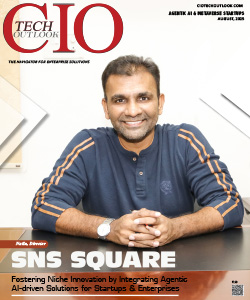Driving Innovation in Manufacturing with Smart Tech
Ashish Thakur, CIO, Cummins India
 Ashish Thakur, CIO, Cummins India, in an interaction with CIOTechOutlook, shared his insights on how MSMEs can adopt smart technologies without massive capital investment. He discussed how Indian manufacturers can foster in-house innovation while staying globally competitive.
Ashish Thakur, CIO, Cummins India, in an interaction with CIOTechOutlook, shared his insights on how MSMEs can adopt smart technologies without massive capital investment. He discussed how Indian manufacturers can foster in-house innovation while staying globally competitive.
Bringing over 17 years of extensive industry experience, Ashish has a proven track record in driving business growth through technology advancements, digitalization and strategic leadership, particularly in developing digital strategies for sales, service, commercial and manufacturing functions. Since joining Cummins India in 2018, Ashish has led the IT function for the Distribution Business Unit (DBU) and New and Recon Parts (NRP) business.
How can smart manufacturing technologies reshape traditional factory models in developing economies? What are the key cultural and organizational shifts needed to embrace Industry 4.0 fully?
Smart manufacturing technologies have the potential to radically transform traditional factory models in developing economies by leveraging innovations like Artificial Intelligence (AI), the Internet of Things (IoT), robotics, and augmented reality. These technologies enable real-time monitoring, predictive maintenance, and process automation, significantly reducing downtime, increasing productivity, and improving resource efficiency. For developing economies, adopting such technologies not only fosters global competitiveness but also aligns manufacturing with Environmental, Social, and Governance (ESG) standards, which are increasingly critical for market sustainability. However, to fully embrace Industry 4.0, cultural and organizational shifts are vital.
Organizations must cultivate a technology-first mindset and embed continuous digital upskilling and learning across all levels of the workforce. Collaboration between traditionally siloed functions is necessary to drive innovation and operational agility. A shift toward data-driven decision-making is essential, allowing businesses to harness the full value of advanced analytics and smart systems. Furthermore, fostering adaptability and a growth mindset within leadership and teams will help overcome resistance to change. These cultural transformations, coupled with smart manufacturing, can modernize industries, boost operational resilience, and contribute to sustainable economic growth, enabling developing economies to compete effectively in an increasingly interconnected global marketplace.
Is “smart” always better? Where should manufacturers draw the line between automation and human expertise? Which smart technologies - AI, IoT, digital twins, or edge computing - are proving most transformative in real-world manufacturing settings?
While "smart" technologies like AI, IoT, digital twins, and edge computing have transformed manufacturing by enhancing efficiency, precision, and scalability, they are not a one-size-fits-all solution. Digitization for the sake of digitization or misapplication can lead to high costs, loss of human expertise, and over-reliance on complex systems. The key is to adopt these tools strategically, ensuring they solve real problems, improve measurable outcomes, and deliver a justifiable return on investment (ROI). Manufacturers must strike a balance, reserving automation for repetitive and data-driven tasks while preserving human judgment, creativity, and flexibility for areas requiring nuanced decision-making.
Practical examples illustrate this nuance. For instance, an automated raw material reordering system driven solely by real-time usage without human oversight can lead to overstocking and inefficiencies. To avoid such issues, manufacturers should evaluate the complexity of tasks, workforce impact, adaptability, and ROI before automating. Ultimately, the smartest technologies are those that align with operational goals, enhance human capabilities, and deliver sustainable value for businesses.
How can MSMEs adopt smart technologies without massive capital investment? What role does predictive maintenance play in driving cost efficiency and operational uptime?
Micro, Small, and Medium Enterprises (MSMEs) can adopt smart technologies without significant capital investment by starting small with pilot projects or proof-of-concept (POC) initiatives that focus on specific operational pain points. Leveraging government incentives, especially those tied to ESG compliance or industry innovation schemes, can help subsidize investments. Partnering with startups, research institutions, or third-party technology providers can offer affordable access to advanced tools and expertise, enabling incremental upgrades rather than large-scale overhauls.
Predictive maintenance, a cornerstone of smart manufacturing, is a cost-efficient solution for improving operational uptime and reducing expenses. This condition-based approach minimizes unplanned downtime, ensures repairs are performed only when necessary, and prevents costly disruptions. By optimizing maintenance schedules and avoiding unnecessary part replacements, MSMEs can allocate resources more effectively while extending equipment life and maintaining optimal machine performance.
Moreover, predictive maintenance enhances workplace safety and product quality by proactively addressing issues that could lead to sudden failures, unsafe conditions, or defective outputs. For MSMEs, this shift from reactive to proactive maintenance reduces operational risks and positions them as competitive, resilient players in the evolving manufacturing landscape.
How can Indian manufacturers foster in-house innovation while staying globally competitive? What’s the role of academia-industry collaboration in advancing smart manufacturing?
In the era of Industry 4.0, Indian manufacturers must embed innovation into their core operations by driving multiple strategic initiatives. These include building a culture of innovation, demonstrating its benefits promptly, ensuring consistent adoption and tracking of outcomes, investing in workforce learning and development, and staying connected with global trends.
It connects research with real-world applications, creating a win-win environment that supports both short-term improvements and long-term industrial growth. Collaboration between academia and industry plays a key role in speeding up the adoption and innovation of smart manufacturing
How smart tech reshaping job roles, and what new skillsets will be essential for the next-gen manufacturing workforce?
Smart technologies are fundamentally reshaping manufacturing job roles by automating repetitive tasks and creating opportunities for advanced, tech-driven positions. While some traditional jobs are being replaced, the integration of automation, robotics, and data-driven tools is generating new roles requiring a blend of technical proficiency, digital expertise, and skills to interpret data.
On the technical side, next-gen manufacturing professionals need skills in programming, electrical and mechanical systems, and the operation and maintenance of advanced machinery such as robotics, IoT devices, and automated equipment. These foundational competencies allow to effectively work with cutting-edge tools and systems on the factory floor.
Digital literacy is equally crucial in this evolving landscape. Employees must be adept at working with data analytics platforms, interacting with connected and cloud-based systems, and interpreting real-time data for informed decision-making. As manufacturing grows increasingly data-driven, the ability to analyze and act on insights becomes indispensable.
In addition to technical and digital skills, continuous learning and upskilling are integral to staying competitive in a fast-paced, tech-transformed industry. Employees must remain agile and embrace new tools, emerging technologies, and best practices to keep pace with innovation.
How can manufacturers protect themselves against cybersecurity threats in hyper-connected factories?
As factories grow increasingly hyper-connected through smart technologies, the risk of cybersecurity threats intensifies. While real-time data sharing, remote operations, and automation drive efficiency, these systems can introduce vulnerabilities that cyberattackers exploit. A single breach can halt production lines, compromise sensitive operational and customer data, and cause significant financial, reputational, and regulatory damages. In highly automated environments, the fallout includes missed delivery deadlines, compliance violations, and erosion of stakeholder trust.
To safeguard against these risks, manufacturers must implement a multi-layered cybersecurity approach. Key strategies include securing networks to protect data in transit, deploying robust endpoint protections for connected devices and machinery, and enforcing strict access controls to limit system changes to authorized personnel. Additionally, encrypting data, ensuring secure cloud configurations, and conducting regular vulnerability assessments are essential.
Employee awareness training is equally critical. Training programs should focus on identifying phishing attempts and preventing social engineering attacks. Continuous monitoring, regular vulnerability assessments, and incident response planning, helps manufacturers stay ahead of evolving threats. In the Industry 4.0 era, cybersecurity is not optional: it’s a foundational requirement for reliable and resilient manufacturing operations.
What ethical considerations arise when AI-driven decision-making takes over human judgment on shop floors?
As AI becomes more common in manufacturing, especially on the shop floor, it is now making decisions that were earlier made by people, such as checking product quality, planning maintenance, managing shifts, and tracking how machines and equipment are used. This helps improve efficiency, but it also brings up some important ethical questions that must be carefully thought through before full-scale implementation. To implement AI responsibly, manufacturers must prioritize ethical guidelines, fairness, and human oversight, ensuring AI complements human judgment rather than replacing it entirely.




